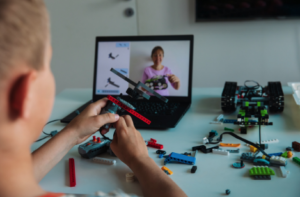Technology has changed the world. So has COVID-19. The Education industry specifically has been flipped upside down by both for different reasons. We wanted to explore this EdTech Evolution and dive into how things have changed, some for the better. We recently sat down with Anna McVeigh-Murphy from CoderZ, a company who has changed the coding and robotics learning game. Anna brought her industry insight, expertise and future predictions within the education technology space that we are going to share. You can also check out our recent Between Two Tablets episode to hear our full conversation. You can also check-out Anna’s own podcast, K12ish, to hear more from her! But first, a little background on Anna:
“I’m with CoderZ, I’m the marketing director there for their North American market. I have been in edtech marketing strategy for the last six years. Prior to that I worked at the Boys and Girls Club for a while, helping to manage their summer programs and their after school programs. And then I did some work as well with the Immigrant and Refugee Council of Oregon – I was an after school tutor through there and would go into the homes of students and provide one-to-one tutoring for immigrant and refugee students who just weren’t getting what they needed in the school system. So that’s how I got my start in education.”
As an Arabic speaker herself, she was hired by a tech company to assist with professional development needs in the Middle East. Through that role, she was able to travel all over the world to train teachers first-hand on various programs.
“I started talking to teachers and I learned so much from my experience with them that I started putting it all together in the company’s blog and taking what they were telling me and kind of translating it into these articles. And so that’s how I ended up in marketing was through content strategy.”
Her journey has taken her from purely the education side into the edtech space which has allowed her to see this industry from all angles. That’s why she was the perfect person to talk to about this shift in the education industry. Having worked first-hand with students, teachers and tech companies allows her a very unique perspective.
EdTech Then and Now
It’s hard to see where you are going if you don’t know where you’ve been. We started off by getting Anna’s take on what edtech looked like 5+ years ago vs. what it looks like now. Here’s what she had to say:
“Five years ago you still had classrooms that weren’t connected to the Internet. So it wasn’t a necessary part of the education experience. It had a lot of untapped potential and whether it was just due to funding they couldn’t get access to, or sometimes some schools didn’t necessarily see the value in it. So five years ago, it was completely under used.”

She talked about an article from The Hechinger Report that said schools had reached 99.99% connectivity – and then the pandemic hit and dismantled some of that progress, especially at home. This highlights some natural growth within the edtech space pre-COVID, includingthings like personalized learning, blended learning and project-based learning. However, it wasn’t the norm.
“Everyone was like ‘ooo that sounds really awesome’, but no one was doing it. Whereas now you have companies like Newsela that just made it the standard for ELA, science and social studies instruction. So now it has to be a given almost in the technology we’re providing to students as well. So a lot of the trends that were becoming popularized are now kind of the standard.”
EdTech in the Home
COVID moved learning from the classroom to the dining room table. That not only put a new challenge on the students and teachers, but also the parents. Anna brings to light how this learning shift affected them:
“In a lot of ways for parents, I think it humbled them to what teachers do every day. But I also think it got them more involved within what their students were learning and becoming more of like a voice for quality within education. In a way, it’s given parents more of a voice in the buying process and made them a bigger stakeholder because they’re now seeing what this instruction looks like.”

There was obviously an impact on students and teachers as well. Students losing important connections result in a negative impact on things like social emotional learning. Anna put it perfectly:
“They want something more than just being in those ‘zoomed out classrooms'”
A positive shift on the teachers side was the fact that many were given free or unlimited access to various programs and the ability to advocate for better options as well. Lots of companies like Nearpod utilized free extended trials as a way to help, but also grow in the long term.
Regardless, this shift has generally put all parties on the same side with a common goal of making education more engaging with better tools and better outcomes.
Digital Equity
There has always seemed to be conversations about equal learning opportunities, but what does that look like within this edtech evolution? Digital equity is a new (but very important) topic to think about when it comes to equality. Anna first explains what digital equity means:
“It should be about digital opportunity. Whether or not students have digital opportunities to learn. It starts as fundamental as ‘do students have access to a device and the Internet.’ And is it adequate access.”
Imagine as an adult having to work entirely from home with no work issued laptop, tablet or phone and you have to rely on your spotty internet service while trying to listen to a very important meeting. Now think about kids trying to learn a new lesson from their teacher using their parents’ phone through a platform that was meant to be used on a laptop. Talk about a challenge. Digital equity goes farther than just the devices and access to them, but also the quality of the learning environment:
“Digital equity also has to do with the quality of learning online. Data points before the pandemic showed that only 35% of teachers were using technology in a way that was hands on. They weren’t giving their students the opportunity to create new things. It was just like putting everything into into a computer program that you could have done on paper. So that’s another big part of it. Are they getting the type of instruction that technology should afford them?”
CoderZ plays a big role in maximizing the opportunity and potential of technology and learning. They have created innovative and engaging platforms that gamify learning and make it more accessible to all. They even partner with Amazon in their ‘Amazon Future Engineer’ program where they created a course called the Amazon Cyber Robotics Challenge.
There is a lot happening at the local level to help with digital equity as well. One school district Anna mentioned partnered with local shops to create wi-fi hotspots for students to use if it wasn’t readily available at home. This was a great quick fix, but long-term Anna wants to see internet access become a utility that is guaranteed to everyone.
Future of EdTech
Technology has changed the world and it’s not going anywhere. If anything, technology allows us to ‘go’ everywhere. It allows a group of four girls from Ghana to win a robotics challenge without having to buy plane tickets to the U.S. Technology also allows little Timmy to zoom through his math class but take more time to learn english thanks to personalized learning.
“I think this is the power of edtech. I think that by giving students access to any type of tech platform that allows them to create in ways that just go beyond what the traditional classroom looks like, you give students an opportunity to discover a passion they didn’t know they had.”

All the best,
Bonny
Check out our latest blogs on microsoldering for data recovery, Spring Break in EdTech, and March Madness!

